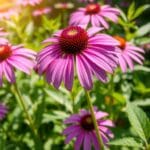Did you know bonsai trees can live for hundreds of years? The oldest bonsai, a ficus retusa linn, is over 1000 years old and still alive today! This ancient art of growing miniature trees has fascinated people all over the world. It combines horticulture and art in a unique way1.
Exploring bonsai, I found many species perfect for beginners. You can choose from the tough Chinese Elm to the delicate Japanese Maple. These trees, grown in shallow containers, add beauty to our homes and gardens21.
In this guide, I’ll share my favorite bonsai trees for beginners. You’ll find indoor and outdoor bonsai options to start your journey. Let’s explore these enchanting miniature trees and find the perfect one for you13.
Key Takeaways
- Bonsai trees can live for centuries, with the oldest known specimen over 1000 years old
- There’s a wide variety of bonsai species suitable for beginners
- Bonsai cultivation combines horticultural skills with artistic expression
- Both indoor and outdoor bonsai options are available for different living spaces
- Choosing the right bonsai species is crucial for success in this rewarding hobby
Introduction to the Art of Bonsai
Bonsai is a fascinating ancient art that has captivated people for centuries. It’s a miniature art form that is truly mesmerizing. Let’s explore the world of bonsai together.
What is Bonsai?
Bonsai is about growing and shaping small trees in containers. It’s not just about keeping trees small. It’s about creating living sculptures that look like their full-sized counterparts in nature. This art combines horticulture with art to create stunning miniature landscapes.
Brief History of Bonsai
The history of bonsai starts in ancient China, where it was called penzai. Chinese artists were the first to grow trees in small pots. Later, bonsai moved to Japan, where it evolved into the Japanese bonsai we know today.
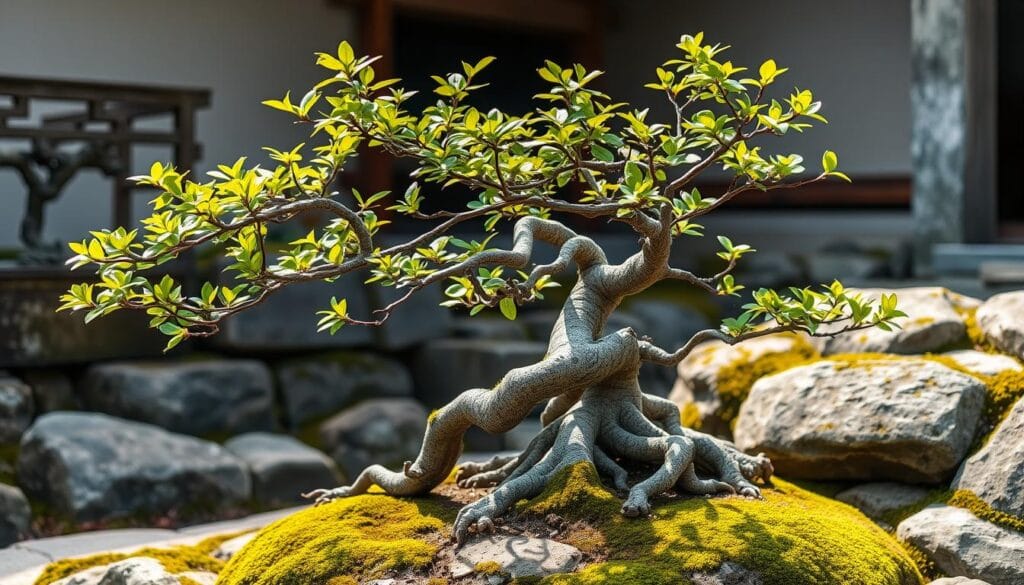
The Appeal of Miniature Trees
What makes bonsai so appealing? It’s the perfect mix of nature and art. These tiny trees bring a piece of the natural world into our homes or gardens. They need patience, care, and creativity, making each bonsai a unique expression of its caretaker’s vision. The challenge of maintaining these living artworks is both rewarding and meditative.
| Aspect | Chinese Penzai | Japanese Bonsai |
|---|---|---|
| Origin | Ancient China | Japan (adapted from China) |
| Focus | Natural landscapes | Individual trees |
| Popular Styles | Penjing, rock planting | Formal upright, slanting, cascade |
Understanding Bonsai Basics
Bonsai is a mix of gardening and art. It needs special skills and knowledge of growing trees in pots. This art makes trees look like tiny versions of their real selves, creating amazing sculptures.
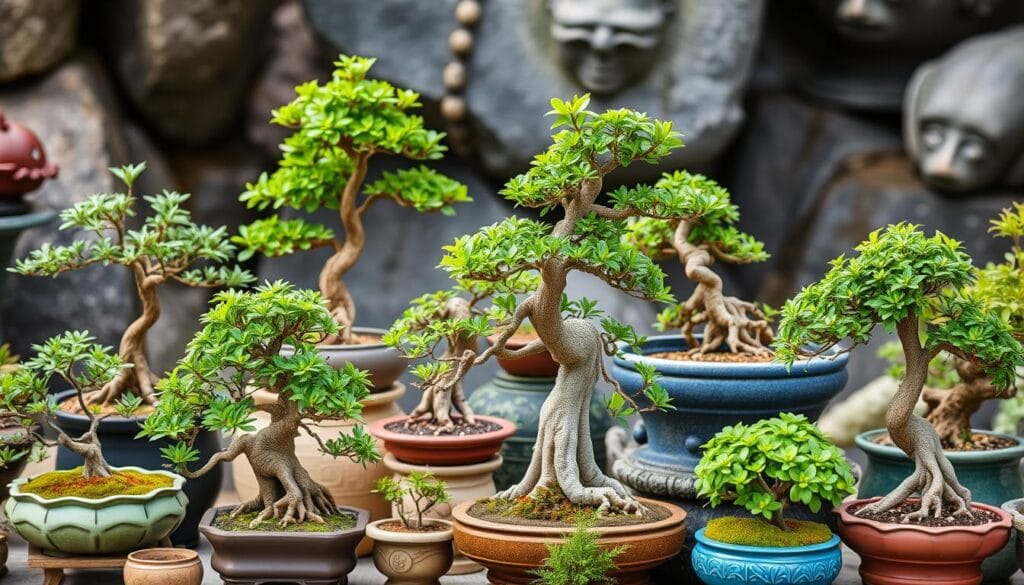
Starting with bonsai basics means picking the right tree. You can choose from styles like formal upright, informal upright, and cascade4. Each style lets you show off the tree’s beauty in a unique way.
Keeping bonsai trees healthy is key. This means regular pruning, shaping with wire, and controlling the roots. The soil mix is special, with ingredients like akadama and lava rock, for good drainage and air.
| Bonsai Style | Characteristics | Suitable Tree Species |
|---|---|---|
| Formal Upright | Straight trunk, symmetrical branches | Pine, Cedar |
| Informal Upright | Curved trunk, natural look | Maple, Elm |
| Slanting | Angled trunk, 60-80 degrees from ground | Juniper, Cypress |
| Cascade | Trunk grows downward, below pot’s base | Pine, Cotoneaster |
| Semi-Cascade | Trunk bends down but stays above pot’s base | Azalea, Flowering Cherry |
Beginners should start with easy-to-grow trees like Ficus and Chinese Elm. These trees do well indoors and are great for beginners in container gardening.
As you get into bonsai, you’ll find many design styles like Bunjin and Ishi-zuke5. The most important thing is to enjoy the journey and learn from each tree you care for.
Why Choose Bonsai as a Hobby?
Bonsai is more than growing tiny trees; it’s a mix of creativity and nature. This ancient art has drawn fans for centuries. It’s not just about small trees; it’s a path of personal growth and artistic expression.
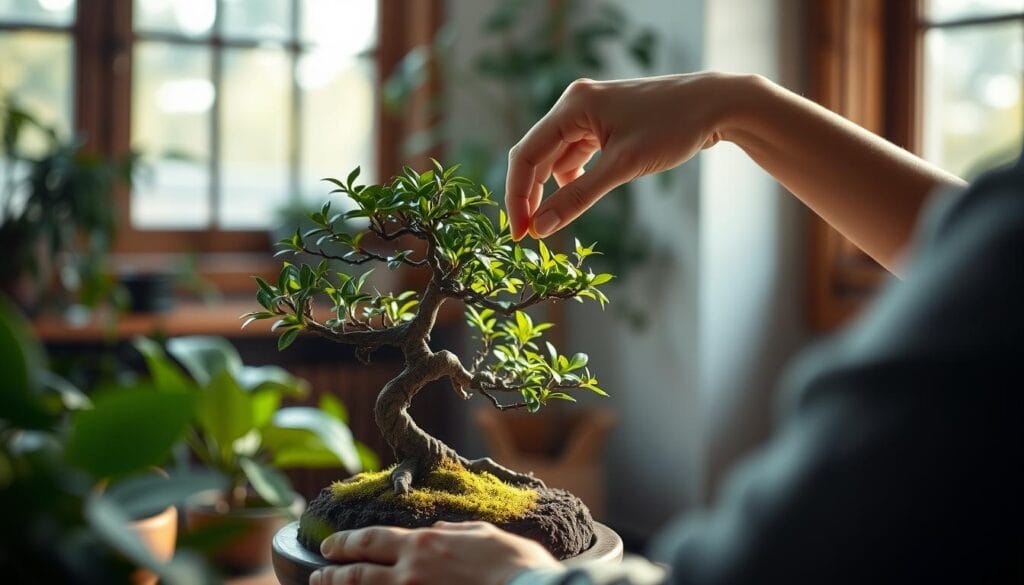
Therapeutic Benefits
Looking after bonsai trees is calming. The focus needed for pruning and shaping clears my mind and lowers stress. It’s like meditation, where I get lost in the details of each leaf and branch. Bonsai trees come in sizes from 6 inches to 3 feet, fitting any space and skill level6.
Artistic Expression
Bonsai is a living art. I enjoy trying out different styles, like the informal upright (Moyogi) and the unique slanting style (Shakan)6. With 30 popular bonsai tree species, I can show my creativity through various shapes and sizes7. It’s amazing to see a simple nursery stock turn into a stunning miniature landscape over time.
Connection with Nature
Bonsai lets me connect with nature, even in cities. I’ve learned a lot about plant growth, seasons, and care. Watching a seed-grown bonsai grow over five years teaches patience and the wonders of nature6.
| Aspect | Benefit |
|---|---|
| Mental Health | Stress reduction, mindfulness |
| Creativity | Artistic expression, design skills |
| Knowledge | Plant biology, horticulture |
| Personal Growth | Patience, dedication |
Choosing bonsai as a hobby has greatly enriched my life. It’s a perfect mix of art, science, and nature that keeps challenging and inspiring me every day.
Factors to Consider When Selecting Your First Bonsai
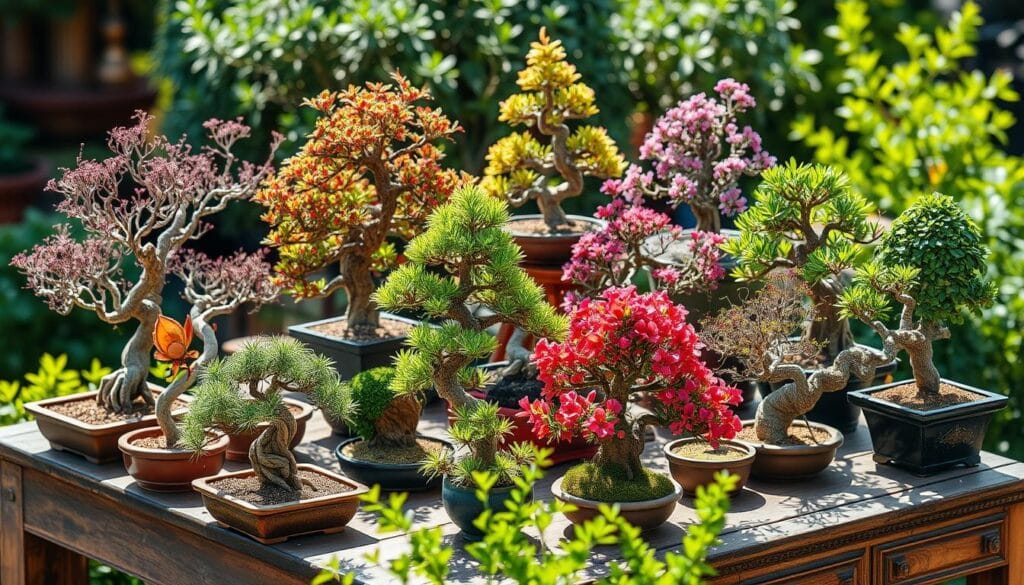
Choosing your first bonsai tree is an exciting step. It’s a journey into an ancient art form. The right bonsai tree species can greatly impact your success and enjoyment.
Start with beginner-friendly species like Juniper, Ficus, Chinese Elm, or Japanese Maple8. These trees are forgiving and easy to care for as you learn.
Think about your local climate when deciding between indoor and outdoor bonsai. Some trees love warmer temperatures, while others prefer cooler ones8. This is key for your bonsai’s health and life span.
Also, consider your available space and time. Indoor bonsai are great if you have little outdoor space. Outdoor bonsai need more attention to weather and seasonal care.
The cost of your first bonsai varies a lot. You might spend $30 for a young tree or up to $300 for a mature one9. Think about your budget and how much you want to invest in this hobby.
| Factor | Consideration |
|---|---|
| Species | Beginner-friendly options (Juniper, Ficus, Chinese Elm, Japanese Maple) |
| Climate | Match tree needs with your local environment |
| Space | Indoor vs. outdoor bonsai |
| Time | Care requirements and commitment level |
| Budget | $30 – $300+ depending on tree age and size |
Lastly, pick a bonsai that you love the look of. Your personal connection to the tree is as important as its care needs8. With these tips, you’ll find the perfect first bonsai for your journey into this fascinating art form.
Indoor vs. Outdoor Bonsai: Making the Right Choice
Deciding between indoor and outdoor bonsai trees is key for beginners. Knowing the needs of different bonsai species is important. Let’s look at some popular choices for both indoor and outdoor spaces.
Indoor Bonsai Species
Indoor bonsai trees are great for small spaces. Ficus bonsai trees are versatile and have unique trunks, making them a favorite indoors10. The Carmona bonsai, or fukien tea, is perfect for beginners and blooms all year10. Jade plants also do well indoors, thriving in bright light or full sun when it’s over 45°F11.
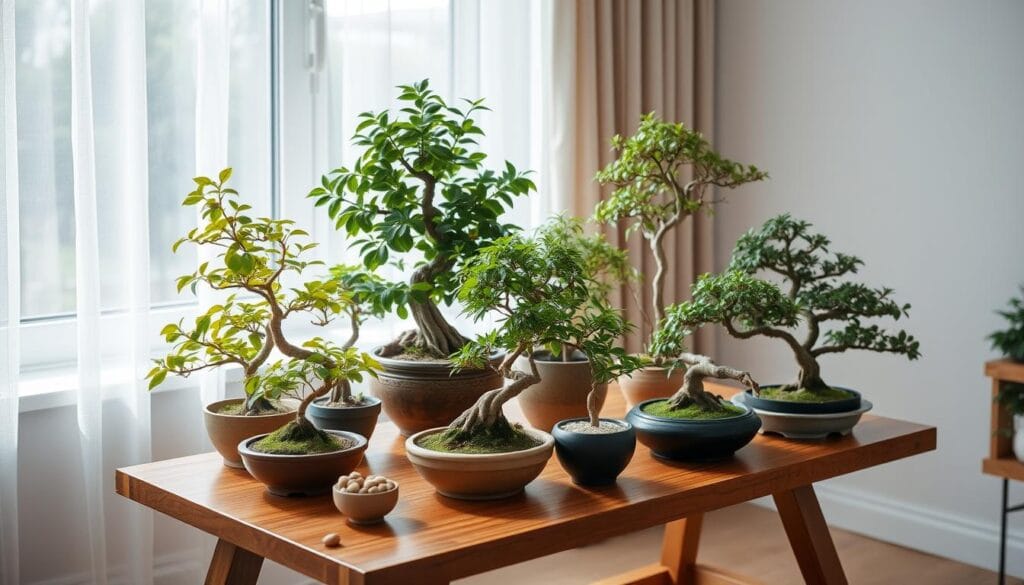
Outdoor Bonsai Species
Outdoor bonsai trees offer more species to choose from. Japanese maple trees are a classic choice, tolerating frost down to 15°F10. They prefer morning sun and afternoon shade to avoid extreme winter temperature swings11. Juniper bonsai trees are easy for beginners and need at least eight hours of sunlight daily and good drainage1011.
Climate Considerations
Climate is crucial for bonsai care. Hardy trees like juniper and pine need protection from harsh winter winds and cold11. In extreme weather, species like Schefflera bonsai are good as they handle low light and moist soil well11.
| Bonsai Type | Environment | Light Requirement | Temperature Tolerance |
|---|---|---|---|
| Ficus | Indoor/Outdoor | Bright light | Above 45°F |
| Japanese Maple | Outdoor | Morning sun, afternoon shade | Down to 15°F |
| Juniper | Outdoor | 8+ hours direct sunlight | Hardy, needs winter protection |
| Jade | Indoor | Bright light or full sun | Above 45°F |
| Schefflera | Indoor | Tolerates low light | Prefers warm temperatures |
30 Popular Bonsai Trees for Beginners
I’m excited to share with you 30 popular bonsai trees perfect for beginners. These species are a great starting point for those new to bonsai12.
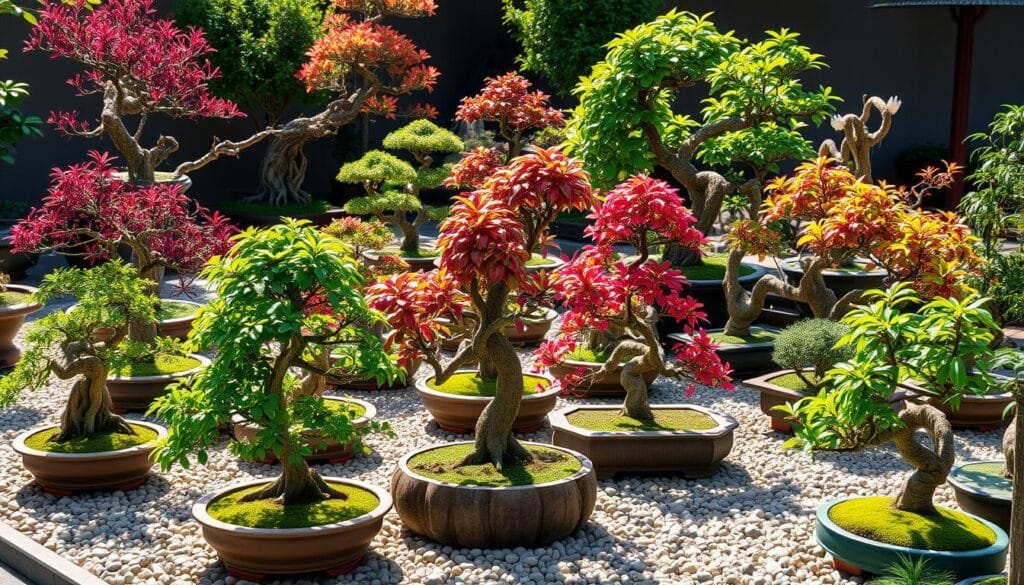
When choosing your first bonsai, think about where you’ll grow it. Only about 1% of tree species are good for indoor bonsai13. Some top indoor species include:
- Ficus
- Fukien tea tree
- Dwarf jade
These trees do well indoors with the right care. If it gets too cold, bring tropical bonsai trees inside when it’s below 45°F13.
Outdoor bonsai lovers have more choices. Some top outdoor species are:
- Japanese Maple
- Juniper
- Chinese Elm
- Boxwood
- Pine varieties (Mugo, Scots, Pitch, Virginia)
Remember, growing bonsai needs attention to lighting, humidity, and watering. For indoor growing, consider grow lights. Full spectrum LEDs from brands like Spider Farmer and Mostthink are good for indoor bonsai13.
With these 30 popular bonsai trees, you’ll find one that fits your style and skill. Happy bonsai growing!
Top 5 Beginner-Friendly Bonsai Species
I’ve found some great bonsai tree species for beginners. These trees are easy to care for and perfect for starting your bonsai journey. Let’s look at my top picks for indoor and outdoor bonsai lovers.
Ficus Bonsai
Ficus bonsai trees are great for beginners. They grow quickly and can start from cuttings. They prefer warm, humid places and do well indoors14. Ficus trees need fertilizer every two weeks when growing fast. They thrive in zones 10-11, ideal for warmer areas15.
Chinese Elm Bonsai
Chinese Elm bonsai trees are another excellent choice. They grow new branches quickly with pruning. If you live in a warm place, these trees can stay outdoors all year14. Chinese Elms are perfect for learning to shape and prune bonsai trees.
Juniper Bonsai
Juniper bonsai trees are tough and love sunlight. They’re best for outdoor bonsai gardens14. Junipers do well in cold weather and can live in zones 3-915. These trees are great for practicing wiring and shaping.
Jade Bonsai
Jade bonsai trees are succulents that need little care. They’re perfect for busy people or beginners. Jade bonsai can handle dry spells and are hard to kill, making them a stress-free choice for beginners.
Japanese Maple Bonsai
Japanese Maple bonsai trees grow fast and have beautiful colors. They’re great for zones 5-815. These trees change colors with the seasons, teaching you about caring for deciduous bonsai trees. They’re a bit more challenging but offer stunning results.
| Bonsai Species | Best for | Care Level | Indoor/Outdoor |
|---|---|---|---|
| Ficus | Fast growth | Easy | Indoor |
| Chinese Elm | Pruning practice | Easy | Both |
| Juniper | Shaping techniques | Moderate | Outdoor |
| Jade | Low maintenance | Very Easy | Indoor |
| Japanese Maple | Seasonal changes | Moderate | Outdoor |
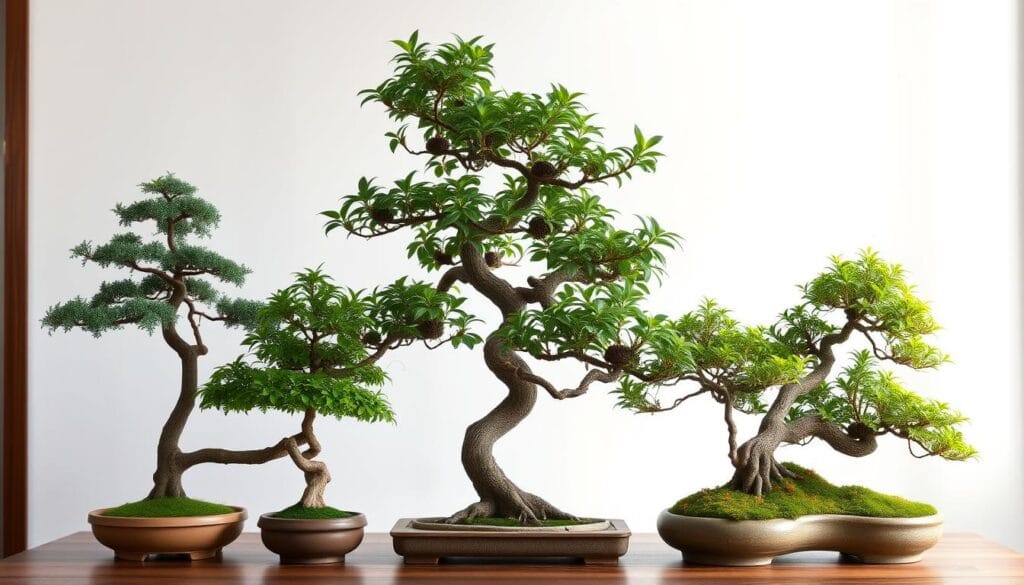
Essential Bonsai Care Techniques
Bonsai is an ancient art of growing plants in containers. It needs special care to thrive. As a bonsai lover, I’ve learned key practices for success in container gardening. Let’s dive into the essential steps to care for your miniature trees.

Watering is crucial for bonsai health. How often you water depends on the tree type, pot size, and where you live. I check the soil daily to avoid watering too much or too little. In Japan, bonsai apprentices can’t water trees alone until they’re five years old16!
Pruning is vital for shaping and keeping the tree small. For broadleaves, I prune in winter when they’re dormant. Conifers need repotting from early February to mid-June17. Any perennial tree or shrub can be turned into a bonsai18.
Fertilizing keeps bonsai healthy. I use a balanced fertilizer with an NPK ratio of 5:5:5, as experts suggest16. This helps the tree grow while keeping it small.
| Technique | Frequency | Importance |
|---|---|---|
| Watering | Daily (as needed) | Critical |
| Pruning | Seasonally | High |
| Fertilizing | Monthly (growing season) | Medium |
| Repotting | Every 1-3 years | High |
Repotting is important for fresh soil and controlling root growth. I use special soil like akadama for its good moisture and drainage16. But, moler clay is also popular for being cheaper and better for the environment.
Learning these techniques will help you grow beautiful bonsai trees. The journey of growing bonsai is as fulfilling as the end result!
Common Challenges for Bonsai Beginners
Starting my bonsai journey was not easy. Many beginners face similar challenges. Knowing these challenges helps in mastering bonsai cultivation.
Overwatering and Underwatering
Finding the right watering balance was tough for me. Root rot from too much water and dehydration from too little are common. Keeping the soil damp and misting leaves daily helps trees grow well19.
Pest Management
Pests can harm bonsai trees, especially indoors. This summer, aphids were a big problem due to a mild winter19. Ants on trees mean aphids are there, sucking sap and spreading diseases20.

To fight pests, I started spraying with insecticide when I saw aphids. Spraying weekly or monthly helps prevent problems19. For bad infestations, Koinor and Plant Care are good solutions20.
Pruning Mistakes
Pruning is key for bonsai health and shape. As a beginner, I made mistakes that hurt my trees. Learning pruning techniques for your tree species is crucial.
| Challenge | Common Mistake | Solution |
|---|---|---|
| Watering | Over or under watering | Check soil moisture daily, adjust watering schedule |
| Pest Control | Ignoring early signs of infestation | Regular inspections, preventative spraying |
| Pruning | Excessive or incorrect pruning | Study species-specific pruning techniques |
Understanding these challenges has helped me improve. With time and effort, you can also master bonsai cultivation and create beautiful trees.
Bonsai Tools and Supplies for Novices
Starting your bonsai journey? You’ll need the right tools to shape and nurture your miniature trees. As a beginner, I found that just a few basic tools can handle most tasks21. This approach aligns well with the principles of container gardening, allowing for precise care in small spaces.
Here’s a list of essential bonsai tools to get you started:
- Pruning shears
- Root hook
- Concave cutters
- Bonsai wire
As you grow in skill, you might want to add specialized tools like wire cutters and knob cutters21. These tools help in the ancient plant cultivation techniques that bonsai embodies.

When choosing tools, consider the material. Carbon steel is budget-friendly, while stainless steel resists rust but costs more21. Japanese bonsai tools are known for their quality, but Chinese tools offer good value21. I’ve found that technological progress has made high-quality Japanese tools more affordable21.
Don’t forget supplies like bonsai soil mix, fertilizers, and pots. These are crucial for maintaining healthy bonsai trees. Some sellers offer tool sets with free shipping and a return policy, making it easier to start your bonsai journey22.
Remember, quality tools are an investment in your bonsai practice. They’ll help you create and maintain beautiful miniature trees for years to come.
Seasonal Care for Your Bonsai Tree
Caring for your bonsai tree means watching for seasonal changes. Each season has its own challenges and chances to help your tree grow. Let’s look at the key care steps for outdoor bonsai and different tree species all year.
Spring Care
Spring is when your bonsai starts growing again. The best time to repot is early March, and most trees need this every 3 years23. I water and fertilize more to help new growth. From March to September, I use organic fertilizers for the best results23.
Summer Maintenance
Summer is when you need to watch your bonsai closely. I water it up to twice a day when it’s very hot23. This helps the plant get nutrients23. In early summer, I do defoliation and wiring because the branches are easy to shape24. If I repot in summer, I cut about 25% less roots than in spring24.
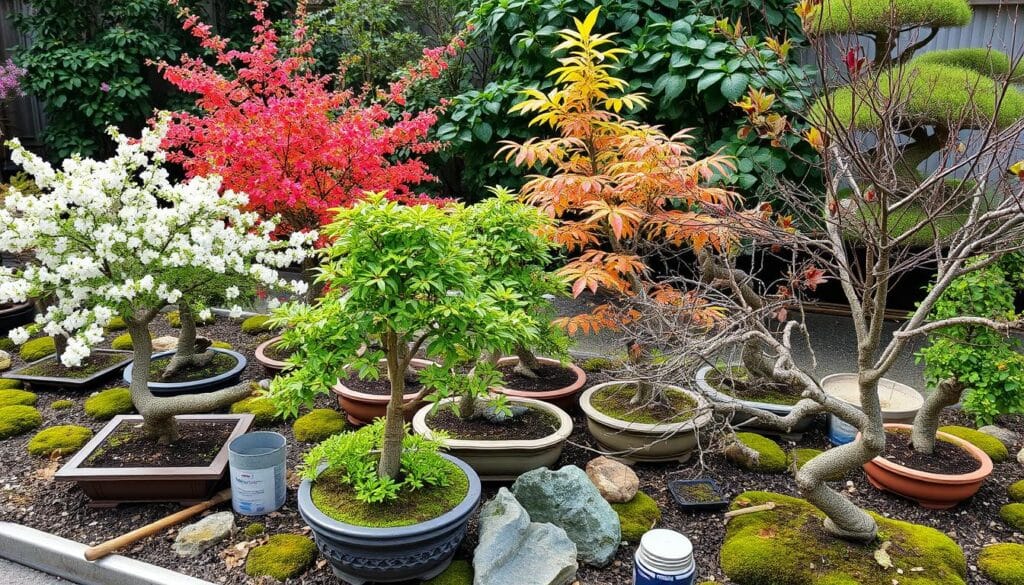
Fall Preparations
In autumn, I water my bonsai less24. It’s important to plan for winter storage when it gets cold24. I move tropical trees indoors when it gets to mid-50s Fahrenheit24. For Mediterranean species, I protect them from harsh frosts23.
Winter Protection
Winter care depends on the tree species. Temperate bonsai like pines and maples can handle cold but need specific low-temperature exposure for vigor25. I keep these in foil tents or unheated greenhouses23. For tropical species like ficus, I shelter them when it gets to the 50s Fahrenheit25. Indoor bonsai do well in bright, cool spots during winter23.
| Season | Outdoor Bonsai Care | Indoor Bonsai Care |
|---|---|---|
| Spring | Repotting, increased watering and fertilization | Gradual increase in watering, light fertilization |
| Summer | Frequent watering, defoliation, wiring | Regular watering, bright indirect light |
| Fall | Reduced watering, winter preparation | Reduced fertilization, maintain humidity |
| Winter | Protection from frost, minimal watering | Bright location, cool temperatures |
Advancing Your Bonsai Skills: Next Steps
As I dive deeper into bonsai, I’m eager to share tips for improving. Whether you’re into japanese bonsai or chinese penzai, there’s always more to learn. This hobby is both fascinating and rewarding.
Improving bonsai skills means understanding the ongoing process of growth. Bonsai trees need constant care for their roots, trunk, and branches26. This means I’m always learning and adjusting as my trees evolve.

To improve, focus on specific areas. Developing the nebari, or root flare, is key from the start and throughout26. Also, trunk development is more important than branches in bonsai styling.
Trying different bonsai tree species is a great way to learn more. Each type, like deciduous, conifer, or tropical, needs a unique approach26. This variety keeps the hobby fresh and exciting.
Consistency is crucial in bonsai. I spend a few minutes with each tree daily, checking them 2 to 4 times a week27. Regular care helps me catch issues early and make small, gradual changes.
Being part of a local bonsai club has been a game-changer. It’s a chance to learn from experts and discover new techniques. I’ve even started exploring advanced methods like deadwood creation and air layering.
Remember, patience is key in bonsai. It’s better to make slow, careful changes rather than big ones27. With time and practice, we can both create stunning miniature trees that show our artistic vision.
Conclusion
Bonsai is a fascinating world with a long history and deep cultural roots. This Japanese art form has been around for over a thousand years, captivating people all over the world28. It’s not just about beauty; it’s a way to connect with nature in a special way.
For beginners, there are 30 popular bonsai trees to choose from. You can pick a tough Ficus Ginseng or a delicate Japanese Maple. Each tree lets you practice patience and creativity29. Remember, bonsai is a long-term journey that requires dedication and learning.
Starting your bonsai adventure means understanding these trees aren’t genetically changed. They’re shaped through careful pruning and root reduction28. This mix of gardening skills and artistic vision makes bonsai so rewarding. So, choose your tree, get your tools ready, and dive into the world of bonsai!
FAQ
What is bonsai?
What are the benefits of bonsai as a hobby?
What factors should I consider when selecting my first bonsai?
What are some popular indoor bonsai species?
What are some popular outdoor bonsai species?
What are the top 5 beginner-friendly bonsai species?
What are some essential bonsai care techniques?
What are some common challenges for bonsai beginners?
What tools and supplies are needed for bonsai cultivation?
How does seasonal care vary for bonsai trees?
How can I advance my bonsai skills?
Source Links
- 30 Types of Bonsai Trees (Indoor) With Pictures: Full Chart
- Beginnings: which trees are good teachers?
- Bonsai Species – Discovering the Highlights of types of bonsai tree
- Bonsai styles, shapes and forms – Bonsai Empire
- Bonsai Design Introduction – Bonsai BCI
- A Beginner’s Guide to Bonsai Trees
- Bonsai as a hobby
- What should you look for when picking out a bonsai tree?
- How do I choose a bonsai?
- Bonsai tree types – 12 bonsai trees you can grow at home
- 7 Types of Bonsai Trees That Are Perfect for Beginners
- Bonsai Trees For Beginners
- Best Trees for Indoor Bonsai
- The Top 3 Bonsai Trees for Beginners – Care Tips
- 11 Best Bonsai Tree Types for Beginners
- Top ten bonsai care tips – from a Kew Gardens expert
- Bonsai maintenance calendar – Bonsai Empire
- Bonsai cultivation and care
- Bonsai Help | Bonsai Help | Trouble Shooting Archives – Bonsai Trees for Sale UK
- Problems and Solutions
- Bonsai Tools for Beginners: 3 things you need to know
- Bonsai Tools Set 20 Pcs Gardening Succulent Tree Indoor Beginner Tool Kit Inc… | eBay
- Bonsai care
- The Only Bonsai Tree Care Calendar You’ll Ever Need
- Winter care for bonsai – Bonsai Tonight
- Seeking resources on how to prune – still indecisive and confused
- Leadership: or the Unexpected Virtues of Bonsai
- Bonsai
- 9 Common Species: Different Types of Bonsai Trees


